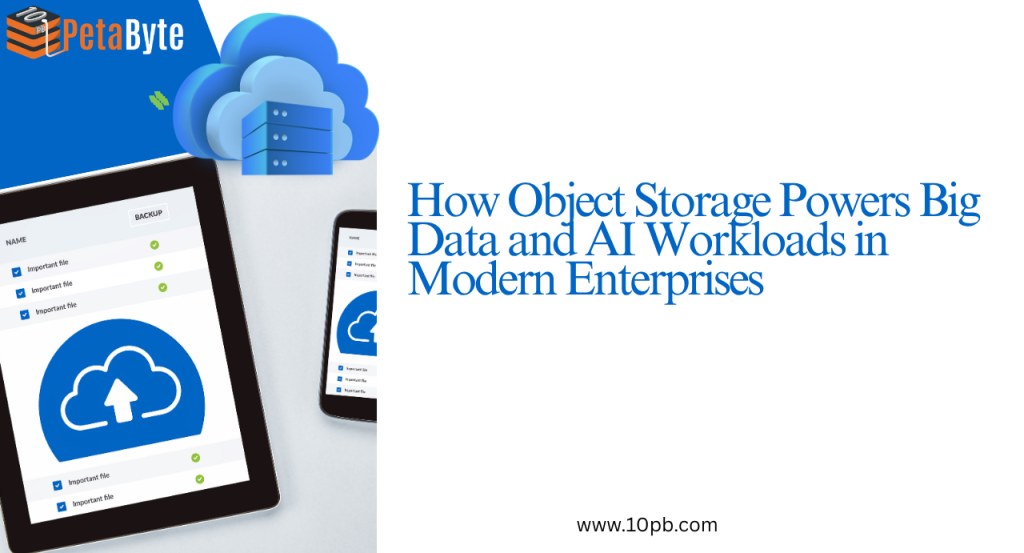With the digital-first economy, businesses are creating and consuming massive amounts of data at accelerating speeds. With real-time machine learning to sophisticated analytics, businesses today need scalable infrastructure to process, store, and manage data in an efficient manner. That is where object storage for big data and for AI comes in — a highly available, scalable, and affordable storage solution that is perfect for supporting big data and AI workloads.
Whether you’re developing AI models, executing deep learning algorithms, or supporting a data lake, object storage provides unparalleled flexibility and scalability. In this blog, we’ll discover how object storage for big data helps big data and object storage for AI workloads and why it’s the foundation of next-generation digital businesses.
What Is Object Storage?
Object storage is a way of storing non-structured data as independent units known as “objects.” An object contains the data itself, metadata, and a distinct identifier so that large amounts of data can be retrieved and handled more conveniently without dependency on conventional hierarchical file systems.
As compared to block or file storage, object storage is optimized for:
- Scalability
- Durability
- Metadata-rich searchability
- Distributed architecture
These characteristics make object storage for AI and big data a perfect match, particularly as data becomes more voluminous and complex.
Why Object Storage Is Perfect for Big Data
Big data is usually defined by the three Vs: volume, variety, and velocity. Businesses require storage solutions that not only manage vast amounts of data but also accommodate different data formats and provide rapid access for real-time processing.
Object storage solves these problems in the following way:
- Scalable Architecture
Current object storage solutions such as 10PB provide petabyte-scale infrastructure that expands continuously with your data. No need to re-allocate storage volumes or concern yourself with hardware constraints — a major advantage when dealing with terabytes or petabytes of log files, IoT feeds, and sensor data.
- Supports Data Lakes
A data lake is a single repository for holding all kinds of structured and unstructured data at any size. Object storage for big data is the foundation for such data lakes by providing low-cost, high-capacity raw and processed data storage.
It enables enterprises to ingest, store, and process data from various sources — like clickstreams, video, social media, and sensors — within a single place, powering downstream AI and analytics workloads.
- High Availability and Redundancy
Big data pipelines cannot be down for even a minute. Object storage provides high availability, redundancy, and geo-replication to ensure your data is available 24/7, which is essential in real-time data analytics and decision-making.
Object Storage for AI and Machine Learning Workloads
AI and machine learning (ML) initiatives require massive amounts of training data, usually in unstructured forms such as images, audio, text, and video. Legacy storage solutions are inadequate when handling such high-volume and unstructured content.
Object storage is well equipped to tackle these challenges:
- Efficient Data Ingestion
Speed is of the essence when it comes to AI pipelines. Parallel data ingestion via object storage for big data facilitates fast data processing and ML model training. It also facilitates plug-and-play compatibility with data pipelines and ETL systems, with immediate access to vast datasets.
- Metadata-Driven Search
AI use cases frequently require finding particular subsets of data in a hurry. Rich metadata tagging in object storage for AI facilitates easier classification, searching, and retrieving data without having to scan entire data sets.
- AI Toolkits integration
Large AI frameworks (e.g., TensorFlow, PyTorch, and Apache Spark) have native access to object storage for AI via APIs, which simplifies workflows for data scientists and ML engineers.
Benefits of Leveraging Object Storage for AI and Big Data
Let’s analyze the main advantages of using object storage for big data and AI workloads:
- Scalability Without Bound – Scale storage with ease without interrupting operations.
- Cost-Effective – Only pay for what you consume, no high-cost storage upgrades.
- Compliant and Secure – Integrated encryption and role-based access to secure your data.
- AI-Ready Architecture – Optimized for storage and retrieval of AI training data in volume.
- High Performance – Parallel processing for faster analytics and AI model training.
Use Case: 10PB Object Storage in Action
A number of companies are implementing solutions like 10PB by NetForChoice to meet their growing object storage for AI and big data requirements. 10PB provides:
- Petabyte-scale storage for new workloads
- Lightning-fast performance with high IOPS
- Seamless integration with AI/ML pipelines
- Enterprise-class security and compliance
Whether you’re in healthcare, finance, e-commerce, or media, 10PB enables you to tap into the full value of your data.
Final Thoughts
As businesses expand data-intensive operations, no aspect of storage infrastructure is more crucial than having consistent, agile, and elastic storage systems. Object storage for big data stands out as the no-brainer solution for big data cloud storage and AI workloads, providing the flexibility and performance necessary to play in today’s digital world.
If your company is developing AI models, working with a data lake, or making an investment in real-time analytics, object storage is no longer a choice — it’s a necessity.

